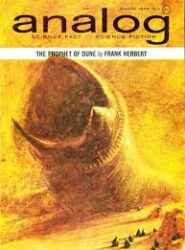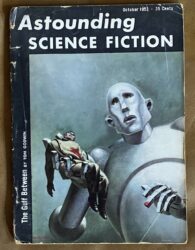
For nearly a century, ‘Analog Science Fiction and Fact Magazine’ has sat at the frontier of science fiction. While it’s fashionable to lump SF, fantasy and horror into one box called “Speculative fiction” these days, ‘Analog’ has always been very much in the science fiction corner and could indeed have been said to have taken the genre from being regarded as trashy disposable fiction to literary acceptance.
Founded in 1930 by Hugo Gernsback as ‘Astounding Stories,’ the magazine underwent several transformations before settling settled on its current name in 1960, by which time the name ‘Astounding’ sounded dated and unrepresentative of the material being published. Under the editorship of John W. Campbell from 1937 to 1971, Analog became the key starting point for modern science fiction. Campbell insisted on scientific rigour in his stories, establishing the magazine’s reputation for “hard science fiction” that would become its hallmark.
 Campbell’s tenure is now referred to as the “Golden Age” of science fiction, Analog introduced readers to many of the writers who would shape the genre including Isaac Asimov, Robert A. Heinlein, and Arthur C. Clarke. These writers, guided by Campbell’s editorial vision, took science fiction from pulp entertainment to a literature of ideas, exploring not just technological possibilities but also their implications for human society. Science fiction as reimagined by ‘Analog‘, and especially by Campbell, became as much about now as the future. Until the 1970s when the influence of Star Wars took the general perception of the genre towards fantasy, the writing which Analog influenced, and the films and TV that spun off from that influence, have used the future, or alternative worlds and histories to illustrate the present. The latest incarnation of that being Apple TV’s ‘For All Mankind.’
Campbell’s tenure is now referred to as the “Golden Age” of science fiction, Analog introduced readers to many of the writers who would shape the genre including Isaac Asimov, Robert A. Heinlein, and Arthur C. Clarke. These writers, guided by Campbell’s editorial vision, took science fiction from pulp entertainment to a literature of ideas, exploring not just technological possibilities but also their implications for human society. Science fiction as reimagined by ‘Analog‘, and especially by Campbell, became as much about now as the future. Until the 1970s when the influence of Star Wars took the general perception of the genre towards fantasy, the writing which Analog influenced, and the films and TV that spun off from that influence, have used the future, or alternative worlds and histories to illustrate the present. The latest incarnation of that being Apple TV’s ‘For All Mankind.’
Throughout its 95-year history, ‘Analog’ has consistently provided a platform for innovative storytelling and speculative thought. Its pages have featured works that predicted technological developments decades before their time—mobile phones, the internet, artificial intelligence, and space travel all appeared in ‘Analog’s’ stories long before they materialised in laboratories.
But perhaps more significant than its technological predictions has been the magazine’s willingness to engage with social and philosophical questions. From explorations of alternative political systems to ruminations on the nature of consciousness, Analog has never shied away from challenging its readers to think deeply about humanity’s place in an ever-changing universe.
Under all its editors, which have included writers Ben Bova, and Stanley Schmidt, the magazine’s commitment to discovering and developing new talent has been firm. Through initiatives like the Dell Magazines Award for Undergraduate Excellence in Science Fiction and Fantasy Writing, Analog continues to ensure that fresh perspectives enter the genre. Writers who made their debut in ‘Analog’s’ pages over all decades have gone on to win Hugo, Nebula, and other prestigious awards.
 Another area that the magazine has influenced is the art of Science Fiction, which has often been harvested for album covers. You may recognise the one on the left first published in ‘Astounding’ in 1953.
Another area that the magazine has influenced is the art of Science Fiction, which has often been harvested for album covers. You may recognise the one on the left first published in ‘Astounding’ in 1953.
What an AI writing tool (another ’Analog’ prediction) would doubtless call the “digital media landscape” is quite different from the one in which it thrived over the last century. But the magazine’s commitment to thought-provoking, scientifically grounded fiction remains as relevant as ever. By continuing to publish stories looking at the implications of emerging technologies, from genetic engineering to quantum computing, ‘Analog‘ helps readers understand a world where the line between science fiction and science fact grows increasingly blurred. It has always been available in the UK, although like many print magazines it has moved to an online subscription and eBook model to survive. But survive it has, and after a round of ownership changes in recent years it, along with sister magazines ‘Asimov’s Science Fiction’ and ‘Fantasy & Science Fiction,’ seem now to be in the hands of a group which will value and cherish it towards it’s centenary.
If you want to learn about the “Golden Age” of SF then read ‘Arkwright‘ by Allen M. Steele. As well as being one of the best hard SF books written this century, it also contains an affectionate look at the 1930s and the world of Campbell, Asimov and others.



Lightspeed digital magazine and Azimovs are also highly recommended